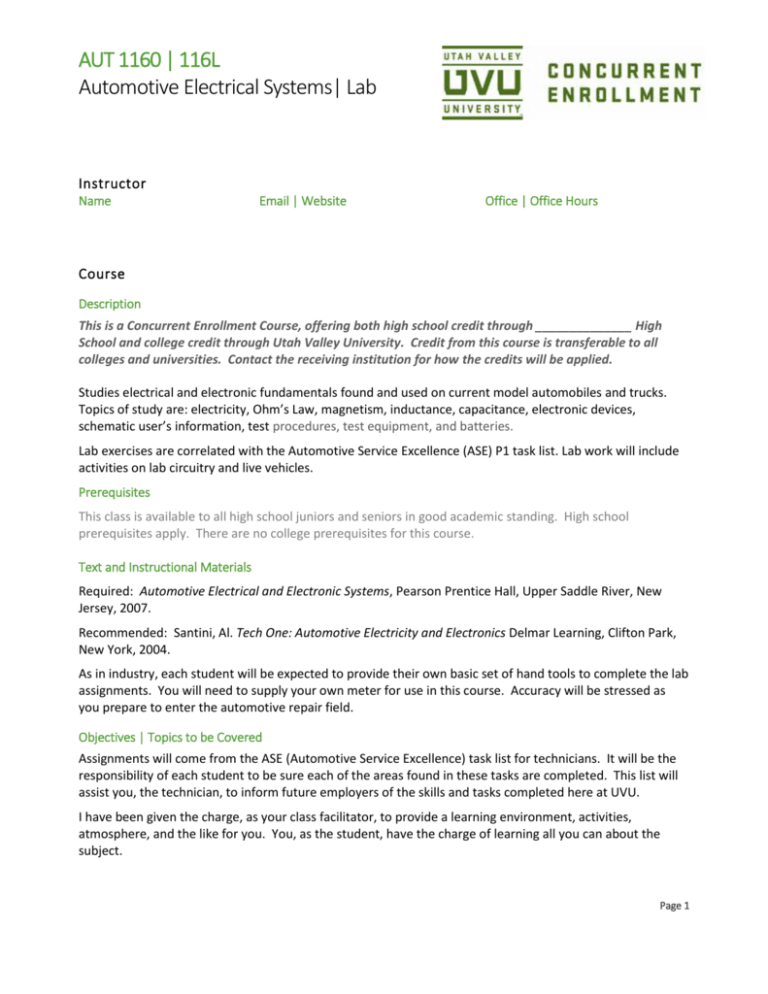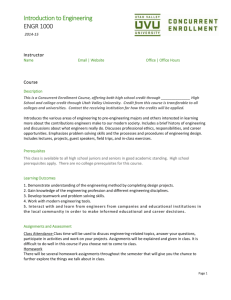
AUT 1160 | 116L
Automotive Electrical Systems| Lab
Instructor
Name
Email | Website
Office | Office Hours
Course
Description
This is a Concurrent Enrollment Course, offering both high school credit through ______________ High
School and college credit through Utah Valley University. Credit from this course is transferable to all
colleges and universities. Contact the receiving institution for how the credits will be applied.
Studies electrical and electronic fundamentals found and used on current model automobiles and trucks.
Topics of study are: electricity, Ohm’s Law, magnetism, inductance, capacitance, electronic devices,
schematic user’s information, test procedures, test equipment, and batteries.
Lab exercises are correlated with the Automotive Service Excellence (ASE) P1 task list. Lab work will include
activities on lab circuitry and live vehicles.
Prerequisites
This class is available to all high school juniors and seniors in good academic standing. High school
prerequisites apply. There are no college prerequisites for this course.
Text and Instructional Materials
Required: Automotive Electrical and Electronic Systems, Pearson Prentice Hall, Upper Saddle River, New
Jersey, 2007.
Recommended: Santini, Al. Tech One: Automotive Electricity and Electronics Delmar Learning, Clifton Park,
New York, 2004.
As in industry, each student will be expected to provide their own basic set of hand tools to complete the lab
assignments. You will need to supply your own meter for use in this course. Accuracy will be stressed as
you prepare to enter the automotive repair field.
Objectives | Topics to be Covered
Assignments will come from the ASE (Automotive Service Excellence) task list for technicians. It will be the
responsibility of each student to be sure each of the areas found in these tasks are completed. This list will
assist you, the technician, to inform future employers of the skills and tasks completed here at UVU.
I have been given the charge, as your class facilitator, to provide a learning environment, activities,
atmosphere, and the like for you. You, as the student, have the charge of learning all you can about the
subject.
Page 1
Hands-on application of theory is a must for the job market you will be entering. You, as a student, CANNOT
charge someone for vehicular work you perform while in the UVU automotive labs.
The lab for this class covers such things as components used in wiring circuits, hazardous materials disposal,
floor cleaning soap, floor dry, grease, FIPG, cleaning solvent, and other consumable materials used in the
lab. Should some components on lab equipment get damaged, the fee covers the repair of those items.
Safety Fundamentals
Brake System fundamentals
Related systems and General Components
Drum Brakes
Park Brakes
Disc Brakes
Power Brakes
Department Policies
Attendance and Participation
Regular attendance and participation is an absolute for the successful completion of this course.
Assessment
Participation ~ Assignments ~ Grading Philosophy
Grades will be awarded based upon the following weighted values and criteria:
Class Assignments, tests & quizzes
40%
Lab Assignments & Performance
40%
Attendance & Safety
20%
All assignments will be given a point value. Each student earns their own points whether you work
individually or in pairs. Shop assignments are to be completed according to industry guidelines and safety
standards. Points are earned by attitude, willingness to work, and quality of work. (Not unlike what you will
encounter on the job.) Points are lost by not participating, i.e. just watching, long breaks, no tools,
inappropriate dress, lack of lab attendance, etc. If you have not already done so, I will want you to develop
good habits that you can take with you into the marketplace.
At the end of the block, all points, including any extra credit points, will be totaled and converted to a
percentage score based on the total points possible. Your course grade will be determined by your over-all
percentage according to the scale below.
Exams
Exams will be given on a regular basis throughout the block to assess your understanding of the subject. The
Final Exam will be given during the regularly scheduled time.
2
Grading Scale
A = 100-93
B - = 82-80
D+ = 69-67
A - = 92-90
C+ = 79-77
D = 66-63
B+ = 89-87
C = 76-73
D - = 62-60
B = 86-83
C - = 72-70
F = 59-0
Grades and Credit
You will receive the same grade for your high school course as you receive for your college course. Your
grade for this class will become part of your permanent college transcript and will affect your GPA. A low
grade in this course can affect college acceptance and scholarship eligibility.
University Policies
Academic Integrity
Utah Valley University expects all students to maintain integrity and high standards of individual honesty in
academic work, to obey the law, and to show respect for others. Students of this class are expected to
support an environment of academic integrity, have the right to such an environment, and should avoid all
aspects of academic dishonesty. Examples of academic dishonesty include plagiarizing, faking of data,
sharing information during an exam, discussing an exam with another student who has not taken the exam,
consulting reference material during an exam, submitting a written assignment which was authored by
someone other than you, and/or cheating in any form. Violators of this policy will be subject to disciplinary
action. Cheating will not be tolerated. It will result in a FAILING grade for the course.
In keeping with UVU policy, evidence of academic dishonesty may result in a failing grade in the course and
disciplinary review by the college. Additional information on this topic is published in the student handbook
and is available on the UVU website.
Students with Disabilities
If you have any disability, which may impair your ability to successfully, complete this course, please contact
the Accessibility Services office, 863-8747, BU 146. Academic accommodations are granted for all students
who have qualified documented disabilities. All services are coordinated with the Accessibility Services
office.
Dropping the Class
_________ is the last day to drop the course without it showing on your transcript.
_________ is the last day to withdraw from the class.
If you drop the high school class, you must also withdraw from the UVU class to avoid receiving an E or UW
(unofficial withdrawal).
Page 3









